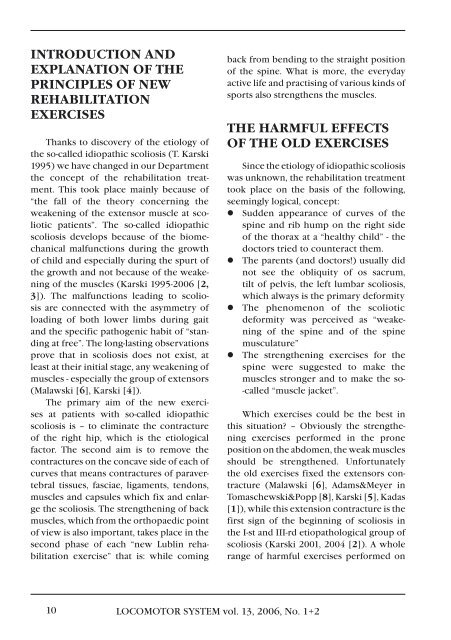1+2/2006 - SpoleÄnost pro pojivové tkánÄ›
1+2/2006 - SpoleÄnost pro pojivové tkánÄ›
1+2/2006 - SpoleÄnost pro pojivové tkánÄ›
You also want an ePaper? Increase the reach of your titles
YUMPU automatically turns print PDFs into web optimized ePapers that Google loves.
INTRODUCTION AND<br />
EXPLANATION OF THE<br />
PRINCIPLES OF NEW<br />
REHABILITATION<br />
EXERCISES<br />
Thanks to discovery of the etiology of<br />
the so-called idiopathic scoliosis (T. Karski<br />
1995) we have changed in our Department<br />
the concept of the rehabilitation treatment.<br />
This took place mainly because of<br />
“the fall of the theory concerning the<br />
weakening of the extensor muscle at scoliotic<br />
patients”. The so-called idiopathic<br />
scoliosis develops because of the biomechanical<br />
malfunctions during the growth<br />
of child and especially during the spurt of<br />
the growth and not because of the weakening<br />
of the muscles (Karski 1995-<strong>2006</strong> [2,<br />
3]). The malfunctions leading to scoliosis<br />
are connected with the asymmetry of<br />
loading of both lower limbs during gait<br />
and the specific pathogenic habit of “standing<br />
at free”. The long-lasting observations<br />
<strong>pro</strong>ve that in scoliosis does not exist, at<br />
least at their initial stage, any weakening of<br />
muscles - especially the group of extensors<br />
(Malawski [6], Karski [4]).<br />
The primary aim of the new exercises<br />
at patients with so-called idiopathic<br />
scoliosis is – to eliminate the contracture<br />
of the right hip, which is the etiological<br />
factor. The second aim is to remove the<br />
contractures on the concave side of each of<br />
curves that means contractures of paravertebral<br />
tissues, fasciae, ligaments, tendons,<br />
muscles and capsules which fix and enlarge<br />
the scoliosis. The strengthening of back<br />
muscles, which from the orthopaedic point<br />
of view is also important, takes place in the<br />
second phase of each “new Lublin rehabilitation<br />
exercise” that is: while coming<br />
back from bending to the straight position<br />
of the spine. What is more, the everyday<br />
active life and practising of various kinds of<br />
sports also strengthens the muscles.<br />
THE HARMFUL EFFECTS<br />
OF THE OLD EXERCISES<br />
Since the etiology of idiopathic scoliosis<br />
was unknown, the rehabilitation treatment<br />
took place on the basis of the following,<br />
seemingly logical, concept:<br />
• Sudden appearance of curves of the<br />
spine and rib hump on the right side<br />
of the thorax at a “healthy child” - the<br />
doctors tried to counteract them.<br />
• The parents (and doctors!) usually did<br />
not see the obliquity of os sacrum,<br />
tilt of pelvis, the left lumbar scoliosis,<br />
which always is the primary deformity<br />
• The phenomenon of the scoliotic<br />
deformity was perceived as “weakening<br />
of the spine and of the spine<br />
musculature”<br />
• The strengthening exercises for the<br />
spine were suggested to make the<br />
muscles stronger and to make the so-<br />
-called “muscle jacket”.<br />
Which exercises could be the best in<br />
this situation? – Obviously the strengthening<br />
exercises performed in the <strong>pro</strong>ne<br />
position on the abdomen, the weak muscles<br />
should be strengthened. Unfortunately<br />
the old exercises fixed the extensors contracture<br />
(Malawski [6], Adams&Meyer in<br />
Tomaschewski&Popp [8], Karski [5], Kadas<br />
[1]), while this extension contracture is the<br />
first sign of the beginning of scoliosis in<br />
the I-st and III-rd etiopathological group of<br />
scoliosis (Karski 2001, 2004 [2]). A whole<br />
range of harmful exercises performed on<br />
10<br />
LOCOMOTOR SYSTEM vol. 13, <strong>2006</strong>, No. <strong>1+2</strong>

















